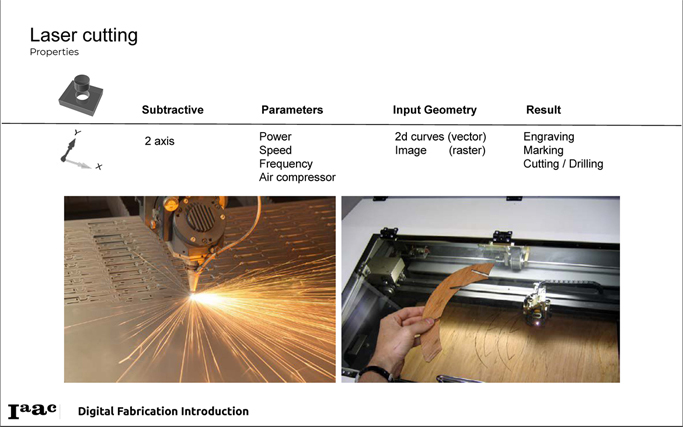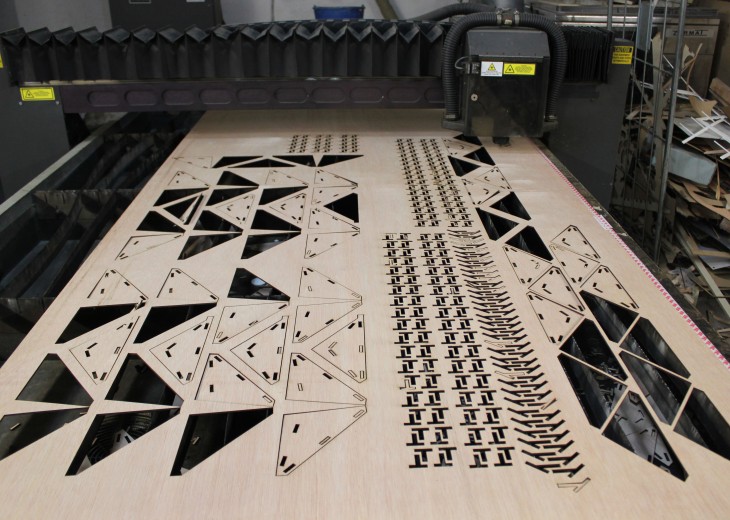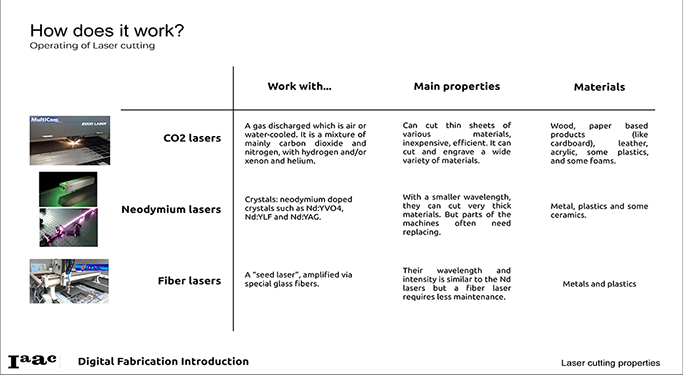Difference between revisions of "Category:Laser Cutting"
(→Types) |
(→Types) |
||
| Line 25: | Line 25: | ||
[[File:Types laser cutter machine.jpg| frame |Types Laser cutter machines]] | [[File:Types laser cutter machine.jpg| frame |Types Laser cutter machines]] | ||
| + | '''CO2 Laser cutter machines''' | ||
| + | Process: A gas discharged which is air or water-cooled. It is a mixture of mainly carbon dioxide and nitrogen, with hydrogen and/or xenon and helium. | ||
| + | Main properties: Can cut thin sheets of various materials, inexpensive, efficient. It can cut and engrave a wide variety of materials. | ||
| − | |||
| − | |||
| − | |||
| − | |||
| − | |||
| − | |||
| − | |||
| − | |||
| − | |||
| − | |||
Materials: Wood, paper based products (like cardboard), leather, acrylic, some plastics, and some foams. | Materials: Wood, paper based products (like cardboard), leather, acrylic, some plastics, and some foams. | ||
'''Neodymium laser cutter machines''' | '''Neodymium laser cutter machines''' | ||
| + | |||
Process: Nd:YAG laser definition. Neodymium-doped Yttrium Aluminum Garnet (Nd: YAG) laser is a solid-state laser in which Nd: YAG is used as a laser medium. These lasers operate in both pulsed and continuous mode. Nd: YAG laser generates laser light commonly in the near-infrared region of the spectrum at 1064 nanometers (nm). | Process: Nd:YAG laser definition. Neodymium-doped Yttrium Aluminum Garnet (Nd: YAG) laser is a solid-state laser in which Nd: YAG is used as a laser medium. These lasers operate in both pulsed and continuous mode. Nd: YAG laser generates laser light commonly in the near-infrared region of the spectrum at 1064 nanometers (nm). | ||
| + | |||
Main properties: With a smaller wavelength, they can cut very thick materials. But parts of the machines often need replacing. | Main properties: With a smaller wavelength, they can cut very thick materials. But parts of the machines often need replacing. | ||
| + | |||
Materials: Metal, plastics and some ceramics. | Materials: Metal, plastics and some ceramics. | ||
'''Fiber Laser cutter machines''' | '''Fiber Laser cutter machines''' | ||
| + | |||
Process: A “seed laser”, amplified via special glass fibers. | Process: A “seed laser”, amplified via special glass fibers. | ||
| + | |||
Main properties: Their wavelength and intensity is similar to the Nd lasers but a fiber laser requires less maintenance. | Main properties: Their wavelength and intensity is similar to the Nd lasers but a fiber laser requires less maintenance. | ||
| + | |||
Materials: Metals and plastics | Materials: Metals and plastics | ||
Revision as of 13:28, 10 June 2020
Laser cutting is a technology that uses a laser to cut materials. Laser cutting works by directing the output of a high-power laser most commonly through optics. The laser optics and CNC (computer numerical control) are used to direct the material or the laser beam generated. A typical commercial laser for cutting materials would involve a motion control system to follow a CNC or G-code of the pattern to be cut onto the material. The focused laser beam is directed at the material, which then either melts, burns, vaporizes away, or is blown away by a jet of gas, leaving an edge with a high-quality surface finish. Industrial laser cutters are used to cut flat-sheet material as well as structural and piping materials.
Laser cutting properties
Contents
History
In 1965, the first production laser cutting machine was used to drill holes in diamond dies. This machine was made by the Western Electric Engineering Research Center.[2] In 1967, the British pioneered laser-assisted oxygen jet cutting for metals.[3] In the early 1970s, this technology was put into production to cut titanium for aerospace applications. At the same time CO2 lasers were adapted to cut non-metals, such as textiles, because, at the time, CO2 lasers were not powerful enough to overcome the thermal conductivity of metals.
Process
Industrial laser cutting of steel with cutting instructions programmed through the CNC interface Generation of the laser beam involves stimulating a lasing material by electrical discharges or lamps within a closed container. As the lasing material is stimulated, the beam is reflected internally by means of a partial mirror, until it achieves sufficient energy to escape as a stream of monochromatic coherent light. Mirrors or fiber optics are typically used to direct the coherent light to a lens, which focuses the light at the work zone. The narrowest part of the focused beam is generally less than 0.0125 inches (0.32 mm). in diameter. Depending upon material thickness, kerf widths as small as 0.004 inches (0.10 mm) are possible.[5] In order to be able to start cutting from somewhere other than the edge, a pierce is done before every cut. Piercing usually involves a high-power pulsed laser beam which slowly makes a hole in the material, taking around 5–15 seconds for 0.5-inch-thick (13 mm) stainless steel, for example.
The parallel rays of coherent light from the laser source often fall in the range between 0.06–0.08 inches (1.5–2.0 mm) in diameter. This beam is normally focused and intensified by a lens or a mirror to a very small spot of about 0.001 inches (0.025 mm) to create a very intense laser beam. In order to achieve the smoothest possible finish during contour cutting, the direction of beam polarization must be rotated as it goes around the periphery of a contoured workpiece. For sheet metal cutting, the focal length is usually 1.5–3 inches (38–76 mm).
Advantages of laser cutting over mechanical cutting include easier workholding and reduced contamination of workpiece (since there is no cutting edge which can become contaminated by the material or contaminate the material). Precision may be better, since the laser beam does not wear during the process. There is also a reduced chance of warping the material that is being cut, as laser systems have a small heat-affected zone. Some materials are also very difficult or impossible to cut by more traditional means.
Laser cutting for metals has the advantages over plasma cutting of being more precise and using less energy when cutting sheet metal; however, most industrial lasers cannot cut through the greater metal thickness that plasma can. Newer laser machines operating at higher power (6000 watts, as contrasted with early laser cutting machines' 1500 watt ratings) are approaching plasma machines in their ability to cut through thick materials, but the capital cost of such machines is much higher than that of plasma cutting machines capable of cutting thick materials like steel plate.
Types
CO2 Laser cutter machines
Process: A gas discharged which is air or water-cooled. It is a mixture of mainly carbon dioxide and nitrogen, with hydrogen and/or xenon and helium.
Main properties: Can cut thin sheets of various materials, inexpensive, efficient. It can cut and engrave a wide variety of materials.
Materials: Wood, paper based products (like cardboard), leather, acrylic, some plastics, and some foams.
Neodymium laser cutter machines
Process: Nd:YAG laser definition. Neodymium-doped Yttrium Aluminum Garnet (Nd: YAG) laser is a solid-state laser in which Nd: YAG is used as a laser medium. These lasers operate in both pulsed and continuous mode. Nd: YAG laser generates laser light commonly in the near-infrared region of the spectrum at 1064 nanometers (nm).
Main properties: With a smaller wavelength, they can cut very thick materials. But parts of the machines often need replacing.
Materials: Metal, plastics and some ceramics.
Fiber Laser cutter machines
Process: A “seed laser”, amplified via special glass fibers.
Main properties: Their wavelength and intensity is similar to the Nd lasers but a fiber laser requires less maintenance.
Materials: Metals and plastics
Methods
There are many different methods in cutting using lasers, with different types used to cut different material. Some of the methods are vaporization, melt and blow, melt blow and burn, thermal stress cracking, scribing, cold cutting and burning stabilized laser cutting.
Vaporization cutting
In vaporization cutting the focused beam heats the surface of the material to boiling point and generates a keyhole. The keyhole leads to a sudden increase in absorptivity quickly deepening the hole. As the hole deepens and the material boils, vapor generated erodes the molten walls blowing ejecta out and further enlarging the hole. Non melting material such as wood, carbon and thermoset plastics are usually cut by this method. Melt and blow Melt and blow or fusion cutting uses high-pressure gas to blow molten material from the cutting area, greatly decreasing the power requirement. First the material is heated to melting point then a gas jet blows the molten material out of the kerf avoiding the need to raise the temperature of the material any further. Materials cut with this process are usually metals.
Thermal stress cracking
Brittle materials are particularly sensitive to thermal fracture, a feature exploited in thermal stress cracking. A beam is focused on the surface causing localized heating and thermal expansion. This results in a crack that can then be guided by moving the beam. The crack can be moved in order of m/s. It is usually used in cutting of glass.
Stealth dicing of silicon wafers The separation of microelectronic chips as prepared in semiconductor device fabrication from silicon wafers may be performed by the so-called stealth dicing process, which operates with a pulsed Nd:YAG laser, the wavelength of which (1064 nm) is well adopted to the electronic band gap of silicon (1.11 eV or 1117 nm). Further information: Wafer dicing
Reactive cutting
Also called "burning stabilized laser gas cutting", "flame cutting". Reactive cutting is like oxygen torch cutting but with a laser beam as the ignition source. Mostly used for cutting carbon steel in thicknesses over 1 mm. This process can be used to cut very thick steel plates with relatively little laser power.
Tolerances and surface finish
New laser cutters have positioning accuracy of 10 micrometers and repeatability of 5 micrometers.
Standard roughness Rz increases with the sheet thickness, but decreases with laser power and cutting speed. When cutting low carbon steel with laser power of 800 W, standard roughness Rz is 10 μm for sheet thickness of 1 mm, 20 μm for 3 mm, and 25 μm for 6 mm. ![]() , where: {\displaystyle S=} S= steel sheet thickness in mm; P= laser power in kW (some new laser cutters have laser power of 4 kW.); V= cutting speed in meters per minute[10]
, where: {\displaystyle S=} S= steel sheet thickness in mm; P= laser power in kW (some new laser cutters have laser power of 4 kW.); V= cutting speed in meters per minute[10]
This process is capable of holding quite close tolerances, often to within 0.001 inch (0.025 mm) Part geometry and the mechanical soundness of the machine have much to do with tolerance capabilities. The typical surface finish resulting from laser beam cutting may range from 125 to 250 micro-inches (0.003 mm to 0.006 mm).[7]
Machine configurations
There are generally three different configurations of industrial laser cutting machines: moving material, hybrid, and flying optics systems. These refer to the way that the laser beam is moved over the material to be cut or processed. For all of these, the axes of motion are typically designated X and Y axis. If the cutting head may be controlled, it is designated as the Z-axis.
Moving material lasers have a stationary cutting head and move the material under it. This method provides a constant distance from the laser generator to the workpiece and a single point from which to remove cutting effluent. It requires fewer optics, but requires moving the workpiece. This style machine tends to have the fewest beam delivery optics, but also tends to be the slowest.
Hybrid lasers provide a table which moves in one axis (usually the X-axis) and move the head along the shorter (Y) axis. This results in a more constant beam delivery path length than a flying optic machine and may permit a simpler beam delivery system. This can result in reduced power loss in the delivery system and more capacity per watt than flying optics machines.
Flying optics lasers feature a stationary table and a cutting head (with laser beam) that moves over the workpiece in both of the horizontal dimensions. Flying optics cutters keep the workpiece stationary during processing and often do not require material clamping. The moving mass is constant, so dynamics are not affected by varying size of the workpiece. Flying optics machines are the fastest type, which is advantageous when cutting thinner workpieces.
Flying optic machines must use some method to take into account the changing beam length from near field (close to resonator) cutting to far field (far away from resonator) cutting. Common methods for controlling this include collimation, adaptive optics or the use of a constant beam length axis.
five and six-axis machines also permit cutting formed workpieces. In addition, there are various methods of orienting the laser beam to a shaped workpiece, maintaining a proper focus distance and nozzle standoff, etc.
Pulsing
Pulsed lasers which provide a high-power burst of energy for a short period are very effective in some laser cutting processes, particularly for piercing, or when very small holes or very low cutting speeds are required, since if a constant laser beam were used, the heat could reach the point of melting the whole piece being cut.
Most industrial lasers have the ability to pulse or cut CW (Continuous Wave) under NC (numerical control) program control.
Double pulse lasers use a series of pulse pairs to improve material removal rate and hole quality. Essentially, the first pulse removes material from the surface and the second prevents the ejecta from adhering to the side of the hole or cut.
Power consumption
The main disadvantage of laser cutting is the high power consumption. Industrial laser efficiency may range from 5% to 45%.[13] The power consumption and efficiency of any particular laser will vary depending on output power and operating parameters. This will depend on type of laser and how well the laser is matched to the work at hand. The amount of laser cutting power required, known as heat input, for a particular job depends on the material type, thickness, process (reactive/inert) used, and desired cutting rate.
Amount of heat input required for various material at various thicknesses using a CO2 laser [watts][14] Material Material thickness 0.51 mm 1.0 mm 2.0 mm 3.2 mm 6.4 mm Stainless steel 1000 1000 1000 1500 2500 Aluminium 1000 1000 1000 3800 10000 Mild steel − 400 − 500 − Titanium 250 210 210 − - Plywood − - − - 650 Boron/epoxy − - − 3000 −
Production and cutting rates
The maximum cutting rate (production rate) is limited by a number of factors including laser power, material thickness, process type (reactive or inert), and material properties. Common industrial systems (≥1 kW) will cut carbon steel metal from 0.51 – 13 mm in thickness. For all intents and purposes, a laser can be up to thirty times faster than standard sawing.
Cutting rates using a CO2 laser [cm/second] Workpiece material Material thickness 0.51 mm 1.0 mm 2.0 mm 3.2 mm 6.4 mm 13 mm Stainless steel 42.3 23.28 13.76 7.83 3.4 0.76 Aluminium 33.87 14.82 6.35 4.23 1.69 1.27 Mild steel − 8.89 7.83 6.35 4.23 2.1 Titanium 12.7 12.7 4.23 3.4 2.5 1.7 Plywood − - − - 7.62 1.9 Boron / epoxy − - − 2.5 2.5 1.1 See also[edit]
This category currently contains no pages or media.


